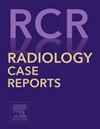年轻成年女性肿瘤诱发心力衰竭:副神经节瘤引发扩张性心肌病1例报告
Q4 Medicine
引用次数: 0
摘要
副神经节瘤是一种罕见的神经内分泌肿瘤,可以分泌儿茶酚胺,导致心血管后果,如儿茶酚胺引起的心肌病和心力衰竭。其发病机制涉及过量的儿茶酚胺暴露,可导致心肌损伤、心功能下降和全身后果。我们讨论一个26岁的成年女性谁提出呼吸困难,矫形呼吸,下肢水肿,并最终被诊断为扩张性心肌病。超声心动图显示LVEF为35%。进一步的检查,包括影像学和生化检查,发现腹部副神经节瘤压迫肾动脉,血浆和尿去甲肾上腺素水平明显升高。一个由心脏病专家、内分泌专家、外科医生和麻醉师组成的多学科团队共同努力,加强术前、术中和术后治疗。术前使用苯氧苄胺阻断,然后保守阻断,确保血流动力学稳定。为了避免过量的儿茶酚胺释放,在手术切除过程中对肿瘤进行了小心的处理。术后患者临床状况明显改善,儿茶酚胺水平及心功能恢复正常。本文章由计算机程序翻译,如有差异,请以英文原文为准。
Heart failure induced by a tumor in a young adult woman: A case report of dilated cardiomyopathy triggered by paraganglioma
Paragangliomas are rare neuroendocrine tumors that can secrete catecholamines, resulting in cardiovascular consequences such as catecholamine-induced cardiomyopathy and heart failure.
The pathogenesis involves excessive catecholamine exposure, which causes myocardial damage, decreased cardiac function, and systemic consequences. We discuss the case of a 26-year-old adult woman who presented with dyspnea, orthopnea, and lower limb edema and was finally diagnosed with dilated cardiomyopathy. Echocardiography revealed an LVEF of 35%. Further investigation, including imaging and biochemical testing, revealed an abdominal paraganglioma compressing the renal arteries and markedly high plasma and urinary normetanephrine levels.
A multidisciplinary team of cardiologists, endocrinologists, surgeons, and anesthesiologists worked together to enhance preoperative, intraoperative, and postoperative treatment.
Preoperative alpha-blockade using phenoxybenzamine, followed by conservative beta-blockade, ensured hemodynamic stability. To avoid excessive catecholamine release, the tumor was carefully handled intraoperatively during surgical excision. The patient's clinical condition improved significantly after surgery, with catecholamine levels and heart function returning to normal.
求助全文
通过发布文献求助,成功后即可免费获取论文全文。
去求助
来源期刊

Radiology Case Reports
Medicine-Radiology, Nuclear Medicine and Imaging
CiteScore
1.10
自引率
0.00%
发文量
1074
审稿时长
30 days
期刊介绍:
The content of this journal is exclusively case reports that feature diagnostic imaging. Categories in which case reports can be placed include the musculoskeletal system, spine, central nervous system, head and neck, cardiovascular, chest, gastrointestinal, genitourinary, multisystem, pediatric, emergency, women''s imaging, oncologic, normal variants, medical devices, foreign bodies, interventional radiology, nuclear medicine, molecular imaging, ultrasonography, imaging artifacts, forensic, anthropological, and medical-legal. Articles must be well-documented and include a review of the appropriate literature.
 求助内容:
求助内容: 应助结果提醒方式:
应助结果提醒方式:


